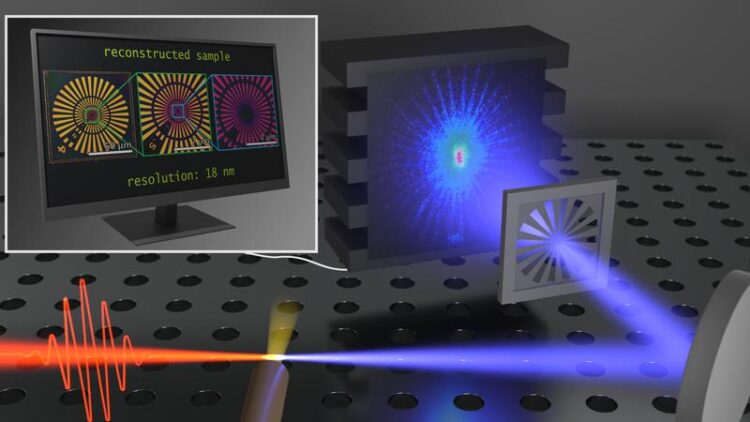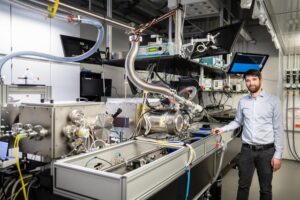Full EUV power on laboratory scale

Robert Klas has already applied his novel EUV source to nanoscale imaging in the laboratory. Here in the picture: A test sample with a so-called siemens star.
© Fraunhofer IOF
Researcher awarded for the development of compact high-power EUV source.
The future has a color: it is extreme ultraviolet. With the help of EUV light it is possible, for example, to produce smaller and more powerful microchips than ever before. But further research faces a problem: Experiments with laser-like EUV light can usually only be conducted at expensive large-scale research facilities. Jena scientist Robert Klas wants to change that. He has developed a compact EUV laser module that can be used to generate this special light much more cost-effectively. Potential applications are possible in semiconductor manufacturing and microscopy. Robert Klas has now been awarded the Hugo Geiger Award for his work.

© Fraunhofer IOF
Researcher Robert Klas from Jena has developed a compact module for generating laser-like EUV light as part of his doctoral thesis. Where research facilities the size of an entire house have been necessary so far, so-called synchrotrons, Klas now presents a new and efficient method to generate laser-like EUV light in a facility the size of a laboratory bench.
Klas’ doctoral thesis, which is the result of cooperation between the Friedrich Schiller University Jena, the Helmholtz Institute Jena and the Fraunhofer Institute for Applied Optics and Precision Engineering IOF, provides the most powerful laser-like EUV source on a laboratory scale to date, with an average power of 10 milliwatts – a hundred times more power than the state-of-the-art in comparable systems when he began his doctorate. This will make EUV research more independent of large-scale facilities that are costly to maintain. In addition, the compact setup costs only a fraction.
EUV source on laboratory scale with one hundred times more power
In his work, Klas is addressing a major challenge in laser optics. An important principle here is that the shorter the wavelength, the harder it is to generate laser radiation. In his research, the physicist is working in the wavelength range from 10 to 50 nanometers. One nanometer corresponds to one millionth of a millimeter. In short, extreme ultraviolet light is extremely difficult to generate directly as laser light.
To solve this problem, Klas uses modern high-power ultrashort pulse fiber lasers. These are converted into EUV light using the process of high harmonic generation. To do this, Klas first focuses the high-power laser in an inert gas. In this process, electrons are accelerated within a few 100 attoseconds. An attosecond is one quintillion of a second. Robert Klas illustrates this order of magnitude with a comparison: »An attosecond is to a second what a second is to our world age,« he explains. The electrons accelerated in this unimaginably short time subsequently produce the precious EUV radiation by recombining with their parent ion.
The main challenge is to coherently superimpose the released radiation, i.e., to control it in such a way that its so-called wave crests in the extreme ultraviolet spectrum add up and can be bundled into a laser beam at the end. Through the correct choice of laser parameters as well as gas density, he has succeeded in generating EUV radiation with laser-like parameters in a highly efficient manner. In combination with high-power driver lasers, this has led to a significant increase in EUV performance.
High-power EUV source sets a new standard in high-resolution microscopy
The scientist is convinced that his work will significantly facilitate further research and application of EUV light: »In the future, the results of my doctoral thesis are expected to drive development in many key areas such as the energy and storage efficiency of chips as well as biology and medicine.«
During his research, Klas already tested the first potential applications for his novel EUV source on a laboratory scale. In exchange with other researchers, he has turned his attention to lens-less microscopy in particular – specifically imaging in the range of tiny nanometers. »With an exposure wavelength of 13.5 nanometers, we have realized a resolution of 18 nanometers, « he reports. By comparison, conventional light microscopes only manage a resolution of just under 500 nanometers. Klas uses another example to illustrate the incredible detail of the microscopy made possible by EUV light: »In one experiment, we achieved a so-called field of view measuring 100 x 100 micrometers. That means we can comparatively cover the size of a soccer field within an image and find a coin in it.«
A further innovation: with EUV-based microscopy, colored images of a sample under investigation can be generated. In this way, researchers can »look inside a cell« and distinguish different elements or proportions of different substances such as carbon, lipids, etc. – »a novelty at such a high resolution,« Klas emphasizes. »With our technology, we can use this to advance biological and medical studies in the future and hopefully study different types of viruses. At some point, we also want to be able to image DNA with a diameter of about two nanometers using this method,« says the scientist.
Quality assurance in semiconductor manufacturing using EUV lithography
Another special application potential is offered by the technology developed by Klas in the field of EUV lithography. Here, tiny microchips are manufactured using extreme ultraviolet light. The semiconductor industry already uses this process to apply more than ten billion transistors to a chip the size of a fingernail. A research team from TRUMPF, ZEISS and Fraunhofer was awarded the German Future Award in 2020 for the development of EUV lithography.
Klas’ research opens a new possibility for quality assurance in this context. This is because the outstanding microscopic properties of his system can also be applied to an exposure mask. This is used in semiconductor manufacturing to produce the tiny EUV chips. If there are defects in this mask, they are passed on to the chips manufactured with it. EUV microscopy can be used to examine the mask for such defects. Detecting weak spots in the EUV mask early on and thus avoiding further errors in production saves time and money. »This process can reduce waste and thus lead to more sustainable production,« says Klas, explaining the benefits of this method.
Honored with the Hugo Geiger Award
Robert Klas has now been awarded the »Hugo Geiger Award for Young Scientists« for his groundbreaking work. The award is granted by the Free State of Bavaria and the Fraunhofer-Gesellschaft to outstanding young researchers. The award ceremony took place on March 21 in Munich. A total of three scientists from Munich, Freiburg and Jena were honored. For further information on the award and the other award winners, please see the press release of the Fraunhofer-Gesellschaft: https://www.fraunhofer.de/en/press/research-news/2023/march-2023/hugo-geiger-pri…
EUV light – the light for the digital age
Light in the extreme ultraviolet range, or EUV light for short, is a very special light. Due to its particularly short wavelength, it can be used to produce tiny structures. This is important in semiconductor manufacturing, for example: Here, EUV light can be used to produce ultra-fine circuits on microchips. This way, semiconductors can be made smaller and at the same time more powerful than ever before. And it is these mini-chips that we urgently need, because without them, progress in artificial intelligence and autonomous driving, for example, would be virtually inconceivable.
Until now, the generation of laser-like EUV light has only been possible in expensive and complex large-scale facilities. Researchers must visit special research centers, so-called synchrotrons, to use these facilities. Scientists often wait years for a place here, to experiment only for a few weeks or even days. Research and further technological progress, which EUV light promises especially in the digital age, are thus massively impeded. Klas aims to remedy this situation in the future with the new, compact EUV source.
About the Hugo Geiger Award
On March 26, 1949, under the patronage of State Secretary Hugo Geiger, the founding meeting of the Fraunhofer-Gesellschaft took place at the Bavarian Ministry of Economic Affairs. To mark the Fraunhofer-Gesellschaft’s 50th anniversary, the Bavarian Ministry of Economic Affairs and Media, Energy and Technology established the »Hugo Geiger Award for Young Scientists«. The prize is awarded annually to three young researchers and recognizes outstanding, application-oriented doctoral theses that were prepared in close cooperation with an institute of the Fraunhofer-Gesellschaft. The individual awards are endowed with 5.000, 3.000 and 2.000 euros. The submissions are evaluated by a jury with representatives from research and development as well as industry. The judging criteria are scientific quality, economic relevance, novelty and interdisciplinarity of the approaches.
Wissenschaftliche Ansprechpartner:
Robert Klas
Fraunhofer IOF
Laser and Fiber Technology Department
Phone: +49 3641 947 – 640
Mail: robert.klas@iof.fraunhofer.de
Weitere Informationen:
https://www.iof.fraunhofer.de/en/pressrelease/2023/euv-power-on-laboratory-scale…
Robert Klas also talks about his research in the Fraunhofer podcast (german only): https://www.fraunhofer.de/de/ueber-fraunhofer/wissenschaftliche-exzellenz/wissen…
Media Contact
All latest news from the category: Information Technology
Here you can find a summary of innovations in the fields of information and data processing and up-to-date developments on IT equipment and hardware.
This area covers topics such as IT services, IT architectures, IT management and telecommunications.
Newest articles

Combatting disruptive ‘noise’ in quantum communication
In a significant milestone for quantum communication technology, an experiment has demonstrated how networks can be leveraged to combat disruptive ‘noise’ in quantum communications. The international effort led by researchers…

Stretchable quantum dot display
Intrinsically stretchable quantum dot-based light-emitting diodes achieved record-breaking performance. A team of South Korean scientists led by Professor KIM Dae-Hyeong of the Center for Nanoparticle Research within the Institute for…

Internet can achieve quantum speed with light saved as sound
Researchers at the University of Copenhagen’s Niels Bohr Institute have developed a new way to create quantum memory: A small drum can store data sent with light in its sonic…





















